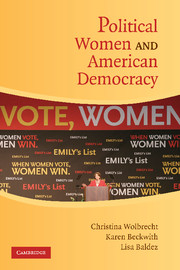Book contents
- Frontmatter
- Contents
- Preface
- List of Contributors
- Political Women and American Democracy
- 1 Introduction: What We Saw at the Revolution: Women in American Politics and Political Science
- 2 Gender as a Category of Analysis in American Political Development
- 3 Gender, Public Opinion, and Political Reasoning
- 4 Gender in the Aggregate, Gender in the Individual, Gender and Political Action
- 5 What Revolution? Incorporating Intersectionality in Women and Politics
- 6 Women's Movements and Women in Movements: Influencing American Democracy from the “Outside”?
- 7 Representation by Gender and Parties
- 8 Women as Candidates in American Politics: The Continuing Impact of Sex and Gender
- 9 Women as Officeholders: Linking Descriptive and Substantive Representation
- 10 Theorizing Women's Representation in the United States
- 11 Political Women in Comparative Democracies: A Primer for Americanists
- 12 Conclusion: Between Participation and Representation: Political Women and Democracy in the United States
- References
- Index
3 - Gender, Public Opinion, and Political Reasoning
Published online by Cambridge University Press: 05 September 2012
- Frontmatter
- Contents
- Preface
- List of Contributors
- Political Women and American Democracy
- 1 Introduction: What We Saw at the Revolution: Women in American Politics and Political Science
- 2 Gender as a Category of Analysis in American Political Development
- 3 Gender, Public Opinion, and Political Reasoning
- 4 Gender in the Aggregate, Gender in the Individual, Gender and Political Action
- 5 What Revolution? Incorporating Intersectionality in Women and Politics
- 6 Women's Movements and Women in Movements: Influencing American Democracy from the “Outside”?
- 7 Representation by Gender and Parties
- 8 Women as Candidates in American Politics: The Continuing Impact of Sex and Gender
- 9 Women as Officeholders: Linking Descriptive and Substantive Representation
- 10 Theorizing Women's Representation in the United States
- 11 Political Women in Comparative Democracies: A Primer for Americanists
- 12 Conclusion: Between Participation and Representation: Political Women and Democracy in the United States
- References
- Index
Summary
Men and women differ in their political attitudes and behavior, but these differences are modest and inconsistent (Sapiro 2003). The much-discussed gender gap in voting choice and partisan preference in which women identify more strongly with the Democratic Party and give greater electoral support to Democratic candidates is real, persistent, and consequential. However, it is also modest in size, with women and men differing in their support for Democratic presidential and congressional candidates by 8 to 10 percentage points on average. This difference is small compared with other political differences across demographic groups such as race, in which the gap in vote choice between blacks and whites is closer to 40 percentage points (Tate 1994). There are also small or inconsistent differences between men and women in many areas of public opinion, leaving researchers to analyze various “gender gaps” of differing origins, in addition to many areas of public opinion in which there are simply no such differences (Schlesinger and Heldman 2001). In reality, men and women both differ and converge politically in interesting ways that deserve the scrutiny of empirical researchers (for a similar point about differences between male and female politicians, see Reingold, this volume).
Differences between men and women are slight, but that does not necessarily neutralize their political power. A difference of even 8 to 10 percentage points can determine the outcome of elections because women represent a larger segment of the voting population than do men.
- Type
- Chapter
- Information
- Political Women and American Democracy , pp. 31 - 49Publisher: Cambridge University PressPrint publication year: 2008
- 67
- Cited by

